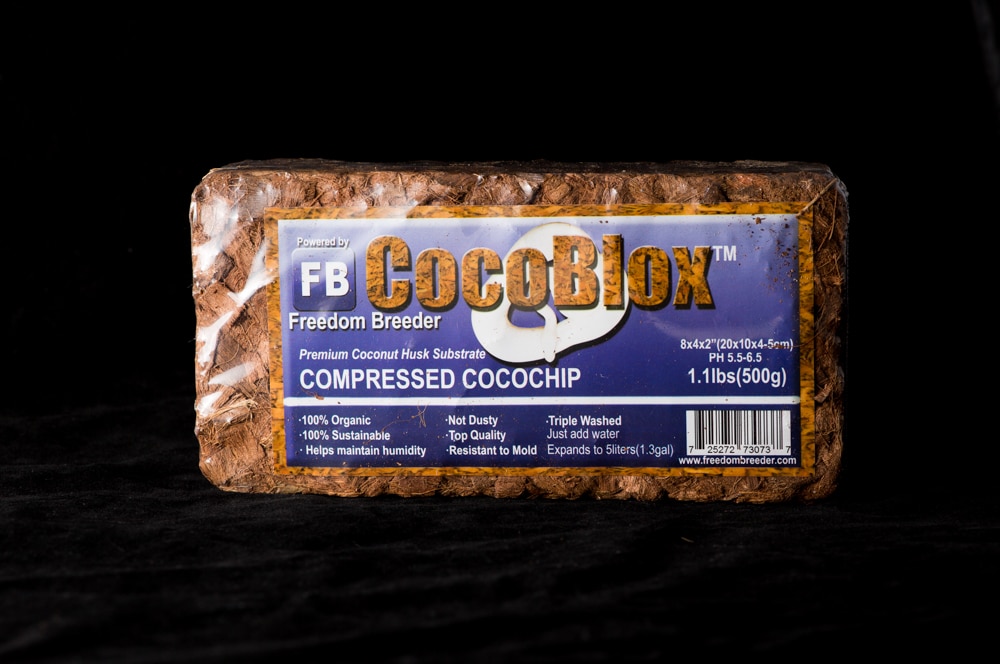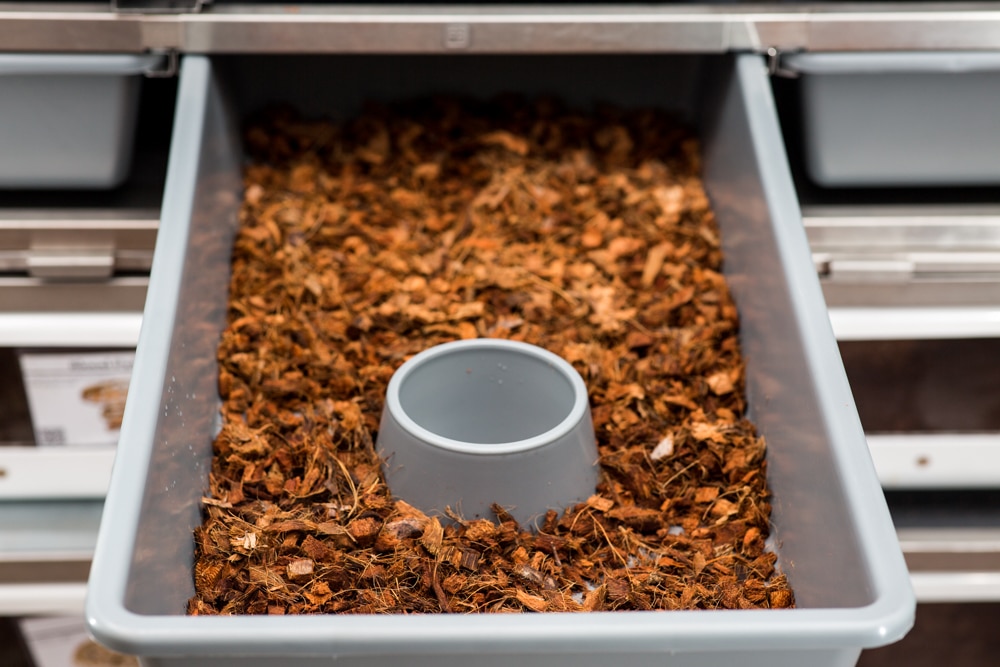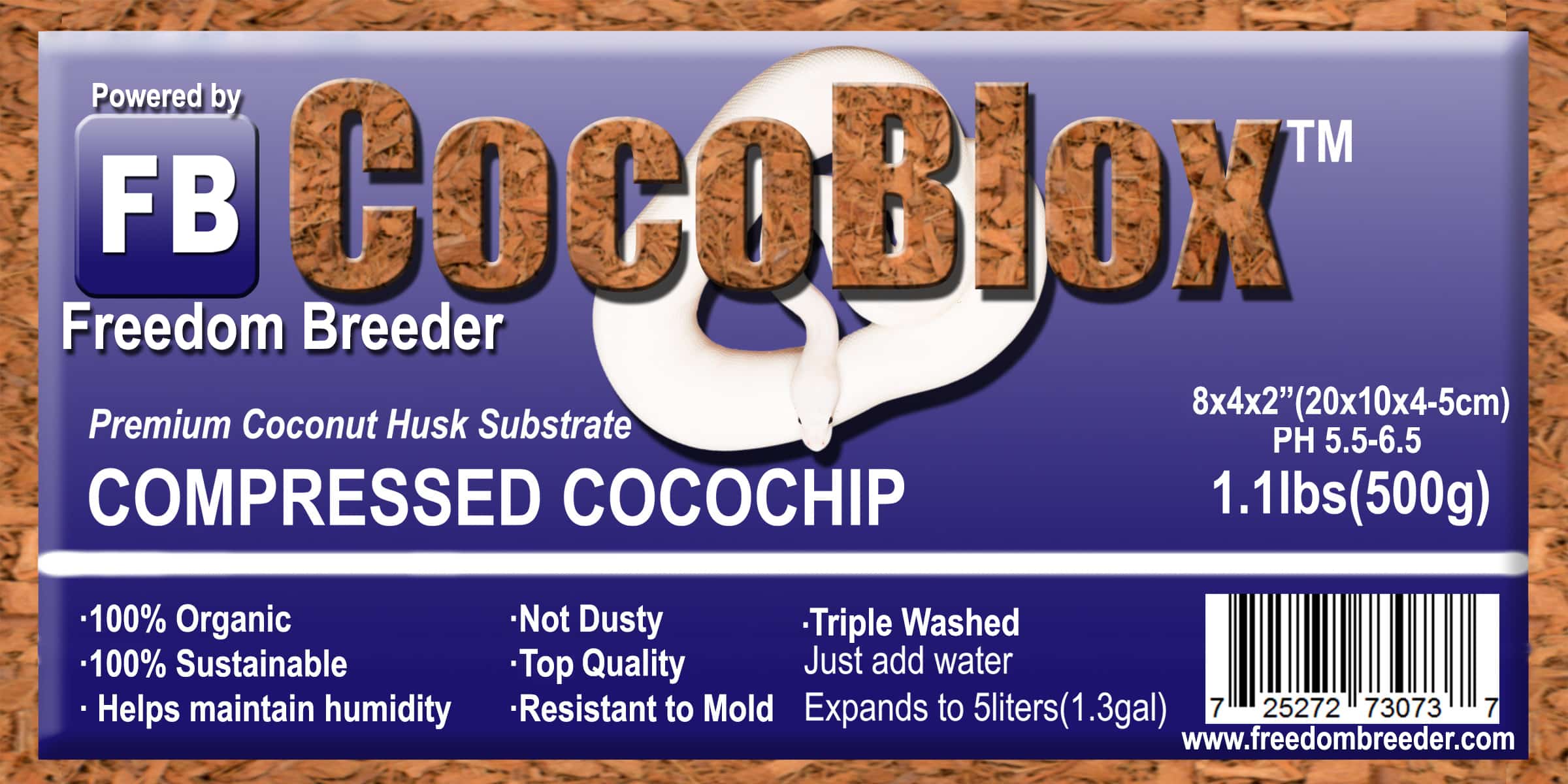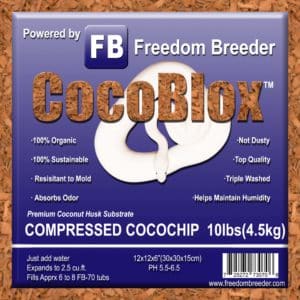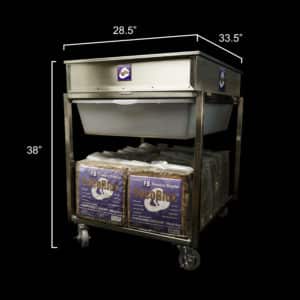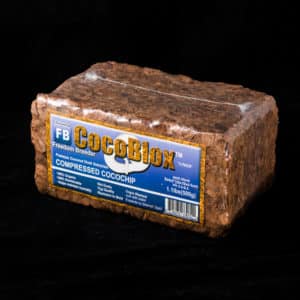Description
Coconut husk is 100% organic, and is 100% sustainable. Coconut substrates have proven to be a superior substrate in the industry due to it’s moisture retention and natural anti-microbial properties. CocoBlox is our premium coconut husk substrate, triple-washed to remove dust and other particulates, and is perfect for use with reptiles, amphibians, arachnids, and even insects of all species. CocoBlox can be sprayed with water for mid-to-high humidity species, or can be left dry for low-humidity species.
Because CocoBlox are manufactured to be the chunkiest, you do not have to worry about hatchlings accidentally ingesting the substrate, which can lead to costly vet bills and possibly fatal impaction issues later on. New CocoBlox users should initially spray with less water than they normally would, as CocoBlox has larger chunks and will retain moisture at higher levels much easier than other substrates.
CocoBlox holds moisture better (and for longer periods of time) in comparison to other coconut husk substrates on the market, due to these chunkier pieces. CocoBlox can easily maintain 60%+ humidity for longer periods without the need for daily misting and can also maintain 80%+ humidity in the right conditions. Our CocoBlox are press-packed into blocks for easy shipping, stacking and storage, but are not packed so tightly that blocks cannot be broken down dry. CocoBlox are manufactured to be very low in sodium and maintain a PH level between 5.5-6.5 as this helps to prolong or even prevent molding of the substrate – which is very rare.
[Please read below for breakdown, use, maintenance, and storage recommendation.]
Prep/Breakdown & Use Recommendations:
- IMPORTANT: It is always recommended to freeze any substrate overnight, prior to use, to ensure any unwanted pests, eggs, larva, etc. are eliminated that may have been picked up during shipping or while in storage.
- Allow blocks to fully thaw (reach room temperature – at center of block) before introducing reptiles.
- It is recommended to punch holes in the packaging, during the thawing process, storage, or before use. This will ensure any trapped moisture is able to dry completely which can help to prevent mycelium outbreaks – see mycelium notice below.
- Step 1: Break down dry block (before adding water) by hand into a storage bin.
- Inspect blocks thoroughly for foreign debris or pieces of string – can be trapped in blocks during press-packing process.
- Step 2: Place a single layer of substrate in to tub, enclosure, or terrarium (enough to fully cover bottom.)
- Additional (deeper layers) substrate can be added if desired, or for burrowing species.
- Substrate will expand considerably, once water is added.
- Step 3: Spray/mist with untreated tap water to saturate substrate.
- Be careful to not oversaturate CocoBlox – retains moisture much better than other products, due to larger pieces.
- Substrate can be left dry for low-humidity species, but more substrate may be needed as it will not expand while dry.
- If using well water to saturate substrate, this should be treated to be safe for reptiles before use.
- Step 4: Allow to sit and expand for a few minutes.
- Step 5: Mix, spray, and repeat.
- Until desired humidity/moisture level is achieved.
- Step 6: Store any unused CocoBlox (See storage recommendations below.)
Maintenance Recommendations:
- CocoBlox should be spot cleaned regularly as this will prevent molding, increase the longevity of the substrate, and helps to maintain cleanliness and health of the animal(s).
- Replace any discarded/soiled substrate with fresh substrate after spot cleaning and mix in with existing substrate.
- Mix and spray substrate when humidity levels have dropped below optimal for any specific species.
- Mixing when spraying will allow substrate to be evenly saturated (will hold humidity levels for longer periods than misting without mixing), and will prolong the life of substrate.
- Full tub/enclosure changes should be done once any/all of the following signs are noticed:
- Substrate no longer holds moisture and dries out very quickly.
- Substrate looks dead (brown or dark-brown in color), and no longer turns that signature coconut bright red-orange color when saturated.
Important Information (regarding coconut & molding conditions)
- All coconut-based substrates can mold, but is very rare, as coconut husk must be in very specific conditions to actually mold versus drying out and dying (without ever molding.)
- Coconut mold is black in color and can be harmful to both you and your reptiles.
- CocoBlox molding is a sign that there is far too much moisture and not enough airflow in your enclosures, tubs, etc. and should be corrected if using CocoBlox.
- Any molded coconut pieces (black in color) should be removed and thrown out immediately.
- Mycelium outbreaks on the other hand (white in color and appears similar to spider-webs growing on top of the substrate), can occur when opening a new block (with any moisture retaining substrate) if the substrate was not fully dry before use or if moisture was sapped into the packaging (why occurrences can happen more during the wet/rainy seasons rather than during the summer months) during shipping, storage, etc. but is very rare, minor, is not harmful, and can be easily prevented or treated.
- Mycelium typically only grows where there is higher humidity, stagnant air, and little to no light.
- If you have experienced a Mycelium outbreak: do not panic, and do not throw out your substrate – as this can be easily remedied.
- Can be a sign your enclosure/room does not have enough airflow.
- Can be prevented by cutting slit/holes in packaging (allowing the CocoBlox to sit over night in a cool and dry place) to ensure substrate is fully dry before use.
- To treat mycelium (takes ~2-6 hours to completely dissipate):
- Step 1: Lightly spray mycelium directly with tap water (this will suffocate the mycelium, and because tap water contains a small amount of chlorine, this will also help eliminate mycelium more quickly.)
- Step 2: Increase airflow to the affected tubs, enclosures or room. Ceiling fan, standing room fans, or similar
- Note: Reptiles should always have fresh air circulation within their enclosure and is very important to their overall health and well being – as stagnant air can contribute to or even cause respiratory infections (RIs). Because CocoBlox has such large pieces and holds humidity so well (when saturated) this can heighten any possible short comings in enclosure setup/design, or husbandry. However, this can also be viewed as a way to receive instant feedback of these potential issues that someone may be less aware of when using other products.
- To treat mycelium (takes ~2-6 hours to completely dissipate):
Storage Recommendations:
- Any open or unused CocoBlox should be allowed to dry out completely before storing (another reason it is not recommended to wet CocoBlox before placing substrate in enclosures.)
- Should be stored in a well-ventilated tub or storage bin (drilling/cutting holes into a Sterilite bin with a lid or similar tub is ideal.)
- Should be stored in a cool and dry place until ready to use (broken down or in block form.)




